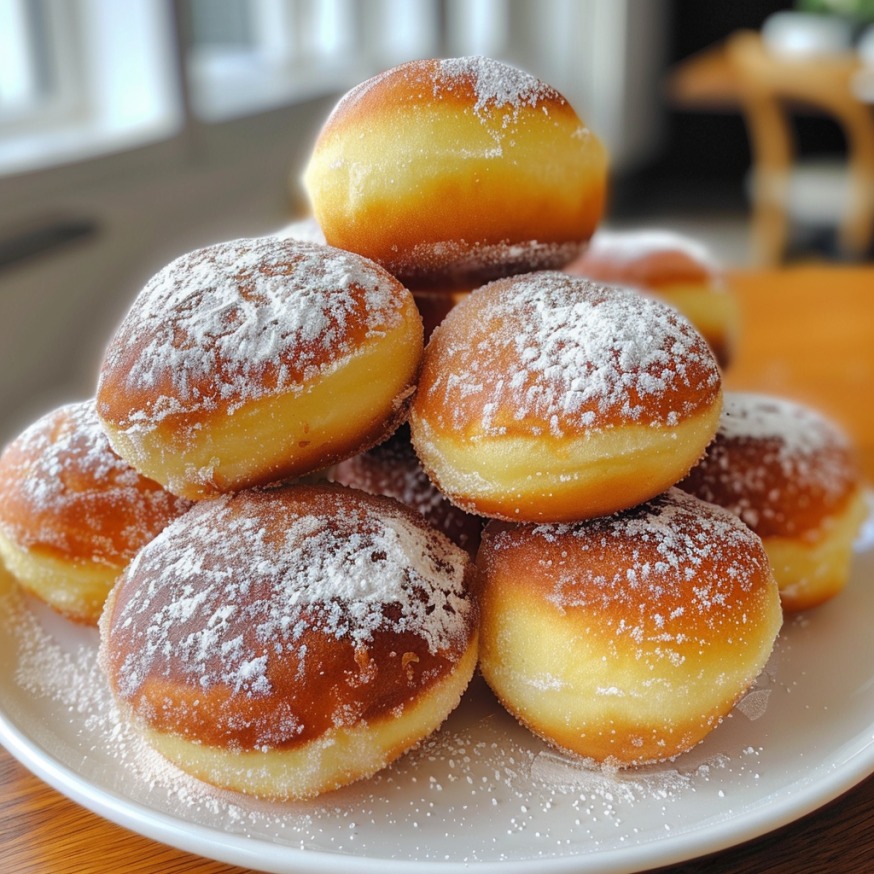Before starting this recipe:
Please refer to the instructions provided on your yeast packaging. Certain yeast varieties can be incorporated directly into the dry ingredients as demonstrated in this recipe, while others require prior activation in a small amount of warm liquid. In such instances, activate the yeast using a bit of the warm milk, avoiding the addition of additional liquid.
How to make the Bomboloni dough
Take a mixing bowl, and mix the flour, sugar, and yeast in it, then stir until combined.
×
Ezoic
Next, evenly distribute the butter cubes over the flour mixture. Next, incorporate the eggs, milk at room temperature, vanilla essence, and a pinch of salt.
Attach the dough hook attachment to the mixer and knead the dough at a low speed for a duration of 10 minutes. If using a KitchenAid mixer, I recommend setting the speed to 2.
Upon completion of the 10-minute kneading process, the dough should exhibit a smooth, stretchy, and slightly sticky texture (please refer to recipe notes 1 & 2 for guidance on using cups as measurements).
Transfer the dough to a clean workspace without using any flour, avoiding extra flour if possible. Shape the dough into a ball by kneading it 2 to 3 times.
Place the ball of dough into a bowl that has been lightly coated with oil and wiped to be clean. Cover the bowl with plastic wrap and allow the dough to ferment for 2-3 hours, or until it has increased three times its original size.
When the dough has risen, transfer it to a clean workspace, gently remove the air, and knead it a few times until it becomes a smooth ball again.
Use your hands to flatten the dough into a ball, then use a rolling pin to shape it into a rectangle that’s ½ inch (1.5 cm) thick.
To make round doughnuts, use either a cookie cutter or a glass with a diameter of 3.5 inches to cut out the dough. Any scraps can be shaped randomly for frying or re-kneaded, then re-rolled and cut out again to make more doughnuts.
Once the doughnuts have been cut, place them on a baking parchment-lined surface and cover with plastic wrap, making sure it’s loose enough for them to rise. Let them prove for a time period of 1 to 1.5 hours or until they’ve tripled in size.
As the doughnuts are proving, prepare the pastry cream according to the instructions provided and let it cool.
Frying
To start frying, heat a large, deep pan or pot filled with oil to a temperature of 170°C/337°F.
Create squares out of the parchment paper, ensuring that each doughnut will have its own individual square
Once the oil is hot, use tongs to carefully place the doughnuts in the pan, removing the parchment paper promptly. It’s best to fry the doughnuts in small, manageable batches to ensure even cooking and prevent overcrowding.
Cook the doughnuts in the fryer for 2 minutes on each side, flipping them once after the initial 2-minute cooking period.
After they’re done, use kitchen paper to remove any excess oil, then roll the doughnuts in sugar. Then, allow the items to cool prior to filling.
How to fill the doughnuts
-
To add filling to the bomboloni, make a small hole by inserting a knife into the side of the doughnut and twisting it around.
-
Fill a piping bag with pastry cream or your choice of filling and pipe it into the bomboloni.
-
For optimal enjoyment, serve the filled bomboloni right away. If you need to store them, place them in plastic containers where they will keep for up to 1-2 days.
To prepare Italian pastry cream (crema pasticciera).
-
Take a large mixing bowl, then mix the egg yolks, sugar, vanilla, and lemon zest with a whisk until a homogeneous mixture is formed and all the ingredients are mixed well.
-
Incorporate the cornstarch into the mixture by whisking until smooth.
-
Place the milk in a saucepan and heat until hot, then remove from heat and let it cool for a minute.
-
Gradually pour the milk into the egg mixture, continuously whisking to prevent the eggs from scrambling and to ensure a smooth texture without any lumps
-
Return the mixture to the saucepan and heat over low heat, stirring continuously until it becomes thick and creamy (approximately 10 to 15 minutes). It’s important to keep the mixture very thick, so avoid increasing the heat as this may cause the eggs to scramble.
-
As the mixture thickens, turn off the heat and transfer it to a freshly washed and drained bowl. Cover the surface of the pastry cream with plastic wrap to prevent a skin from forming, and let it cool.
ADVERTISEMENT

